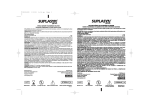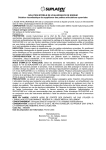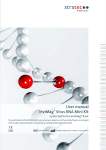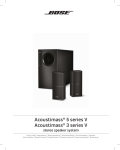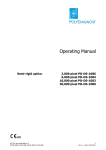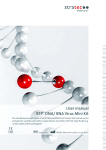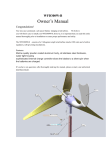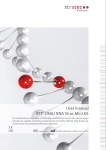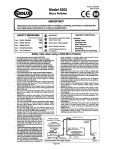Download SUPLASYN
Transcript
SUPLASYN ® SOLUTION STÉRILE DE HYALURONATE DE SODIUM Agent de remplacement du liquide synovial L’ACIDE HYALURONIQUE (AH) est un constituant normal du liquide synovial; il joue un rôle essentiel dans le milieu physiologique interne de l’articulation. COMPOSITION: Solution viscoélastique d’un poids moléculaire défini d’acide hyaluronique purifié, produit par fermentation. Chaque seringue contient: Sel sodique de l’acide hyaluronique………………..20 mg Excipient q.s………………………………………......2 ml PROPRIÉTÉS: L’acide hyaluronique est le prototype d’une vaste gamme de biopolymères saccharides (glucosaminoglycanes ou mucopolysaccharides), composants largement présents dans toutes les structures extracellulaires des tissus, notamment du cartilage et du liquide synovial. Le principe actif de SUPLASYN est de l’acide hyaluronique hautement purifié et constitué par une chaîne moléculaire de longueur définie. L’injection de SUPLASYN dans l’espace synovial contribue à normaliser l’articulation après une arthrocentèse. INDICATIONS: Comme agent de remplacement du liquide synovial après une arthrocentèse. SUPLASYN a montré un effet bénéfique dans l’amélioration de la fonction articulaire et le soulagement de la douleur provoquée par l’arthrose. MODE D’EMPLOI ET POSOLOGIE: Selon la taille de l’articulation, administrer jusqu’à 2 ml de SUPLASYN par voie intra-articulaire. Le traitement recommandé est d’une injection par semaine pendant 3 semaines; suivant la condition du patient, il est possible d’aller jusqu’à 6 injections à intervalles d’une semaine. Respecter des conditions aseptiques strictes. Plusieurs articulations peuvent être traitées en même temps. Eliminer le contenu inutilisé de la seringue. Pour injecter le contenu de la seringue, ôter la capsule de verrouillage Luer-Lock, utiliser une aiguille adaptée (21-25 G suivant l’articulation) et assurer sa fixation en la tournant légèrement. LA GRADUATION SUR L’ÉTIQUETTE DE LA SERINGUE EST À UTILISER À TITRE INDICATIF UNIQUEMENT. CONTRE-INDICATIONS/PRÉCAUTIONS: Ne pas administrer aux patients ayant des antécédents d’hypersensibilité. Respecter les précautions et contre-indications usuelles pour toute injection intra-articulaire. Ne pas injecter par voie intra-vasculaire. SUPLASYN ne doit pas être utilisé chez des patients présentant une inflammation/irritation de l’articulation, puisque des effets indésirables surviennent plus fréquemment chez ces patients. En l’absence de données cliniques sur l’emploi de l’acide hyaluronique chez l’enfant, la femme enceinte ou allaitant, l’administration de SUPLASYN est déconseillée chez ces patient(e)s. Le patient devra se reposer 2448 heures après l’injection et éviter tout effort soutenu pendant toute la durée du traitement. Le patient peut éprouver une douleur passagère après l’injection intra-articulaire. L’articulation touchée peut présenter une réaction locale comme de la douleur, une sensation de chaleur, de l’hyperthermie, une rougeur, un gonflement, une inflammation, ou de l'irritation. Si ces symptômes apparaissent, mettre l’articulation au repos et appliquer localement une poche de glace. Ces symptômes disparaissent généralement en quelques jours chez la plupart des patients. Dans certains cas, des signes d’hypersensibilité se produisent sous forme de réactions locales plus sévères (douleur, irritation, gonflement, inflammation, effusion). Dans ces cas, une intervention thérapeutique peut être nécessaire (par exemple une aspiration du liquide articulaire). Les effets indésirables locaux peuvent être accompagnés de réactions systémiques telles que fièvre, frissons, réactions cardiovasculaires, et rarement une réaction anaphylactique. De très rares cas d’éruptions cutanées, démangeaison, urticaire, baisse de pression artérielle ou de synovite ont été rapportés après l’administration de SUPLASYN. Arrêter le traitement en cas de réactions indésirables. Éviter l’emploi de SUPLASYN avec des instruments stérilisés à l’aide de solutions contenant des sels d’ammonium quaternaire. MISE EN GARDE: GARDER HORS DE LA PORTÉE DES ENFANTS. NE PAS UTILISER SI L’EMBALLAGE EST ENDOMMAGÉ. RÉSERVÉ À UN USAGE MÉDICAL EXCLUSIVEMENT. CONDITIONNEMENT: Seringue de 2 ml prête à l’emploi. Boîte de 1 ou 3 seringues. CONSERVATION: À conserver entre 4°C et 30°C. NE PAS CONGELER. Porter à température ambiante avant l’injection. REMBOURSEMENT SÉCURITÉ SOCIALE: Conformément à la LPPR (code 1149448), la prise en charge est assurée pour les patients atteints de gonarthrose, après échec des antalgiques et échec ou intolérance aux antiinflammatoires non stéroïdiens (AINS), dans la limite d’un traitement (composé de trois injections à une semaine d’intervalle) maximum par an et par genou. Elle est subordonnée à la prescription et à la réalisation de l’injection intra-articulaire soit par un rhumatologue, soit par un chirurgien orthopédique, soit par un médecin de médecine physique et de réadaptation. Elle est assurée pour un conditionnement de trois seringues contenant chacune une dose minimale d’acide hyaluronique supérieure à 15 mg. Code ACL : 4680569 Date d’élaboration de l’information: Mars 2004 Mise à jour de l’information: Janvier 2009 ® Bioniche Pharma Group Limited, Ireland Bioniche Teo., Inverin, Co. Galway, Ireland. Distribué par: Nordic Pharma, 216 Boulevard Saint Germain, 75007 Paris, France, Tel: 01 72 46 72 00, [email protected] SUPLASYN® STERILE SODIUM HYALURONATE SOLUTION Synovial Fluid Replacement HYALURONIC ACID (HA) is a normal component of the synovia and plays a central role in maintaining the physiologicalinternal environment of the joint. COMPOSITION: Viscoelastic solution of a defined molecular weight of purified hyaluronic acid, produced by fermentation. Each syringe contains: Hyaluronic acid sodium salt……………………..20 mg Excipients q.s………………………………………2 ml PROPERTIES: Hyaluronic acid is the prototype of a wide range of saccharide biopolymers (glycosaminoglycans or mucopolysaccharides), important components of all extracellular tissue structures, including cartilage and synovial fluid. The active substance of SUPLASYN is a hyaluronic acid of defined molecular chain length with a high degree of purity. The introduction of SUPLASYN into the synovial space will assist in the normalization of the joint following arthrocentesis. INDICATIONS: As a replacement for synovial fluid following arthrocentesis. SUPLASYN has been shown to be beneficial in osteoarthritis for the management of pain and improvement in physical function of joints. DOSAGE AND ADMINISTRATION: Depending upon joint size, up to 2 ml may be administered intra-articularly. The recommended schedule is 1 injection per week for 3 weeks, but up to 6 may be given depending on patient’s condition. Use strict aseptic technique. More than one joint may be treated at the same time. Discard any unused portion of the syringe. To use the pre-filled syringe, remove the Luer lock cap, attach a suitable cannula (recommended is 21 – 25 G depending on joint) and secure it by turning slightly. GRADUATION ON THE SYRINGE LABEL IS TO BE USED AS A GUIDE ONLY. CONTRAINDICATIONS/PRECAUTIONS: Do not administer to patients with known hypersensitivity reactions. Respect usual precautions and contraindications for any intra-articular injection. Do not inject intra-vascularly. SUPLASYN should not be used in patients presenting an inflammation/irritation of the joint, since adverse events more commonly occur in patients with already existing joint inflammation/irritation. As no clinical evidence is available on the use of Hyaluronic Acid in children, pregnant and lactating women, treatment with SUPLASYN is not recommended in these patients. The patient should rest 24-48 hours after the injection and avoid any strenuous activity over the full course of the treatment. Transient short duration pain may occur following intra-articular introduction. The affected joint may show a mild local reaction like pain, feeling of heat, hyperthermia, redness, effusion, irritation, and swelling/inflammation. If these symptoms occur, rest the affected joint and apply ice locally. Symptoms subside within days for most of the patients. In some cases, mild local reactions such as pain, irritation, swelling/joint inflammation and effusion may be significantly enhanced and much more severe as an expression of hypersensitivity. In such cases, a therapeutic intervention could be necessary, e.g. aspiration of joint fluid. Local adverse reactions could be accompanied by systemic reactions such as fever, chills, or cardiovascular reactions, and in rare cases anaphylactic reactions. In extremely rare circumstances, rash/itching, urticaria, synovitis, and a drop in blood pressure have been reported following the administration of SUPLASYN. Discontinue use if adverse reactions are experienced. Avoid using SUPLASYN with instruments sterilised with quaternary ammonium salts solutions. WARNING: KEEP OUT OF REACH OF CHILDREN. DO NOT USE IF BLISTER IS DAMAGED. TO BE USED BY A PHYSICIAN ONLY. PACKAGING: Available in 2ml pre-filled syringes; packages of 1 and 3. STORAGE: Store between 4°C and 30°C. DO NOT FREEZE. Bring to room temperature before injection. Date of Preparation: March 2004. Revised: January 2009 ® Bioniche Pharma Group Limited, Ireland Bioniche Teo., Inverin, Co. Galway, Ireland.



